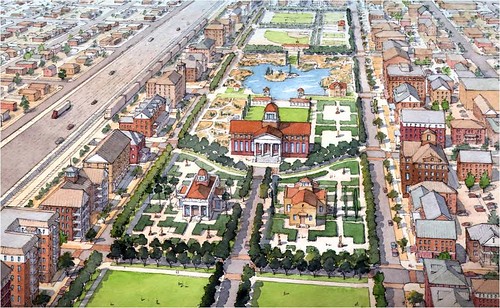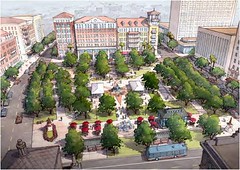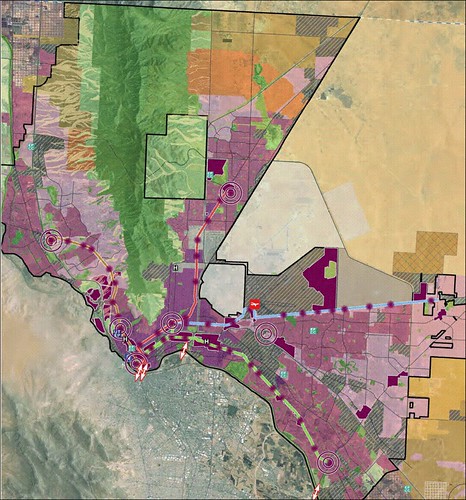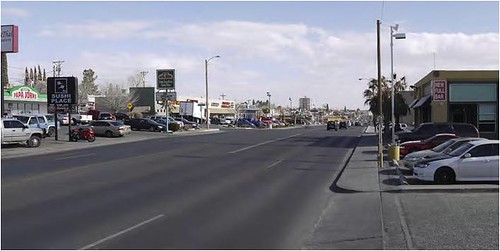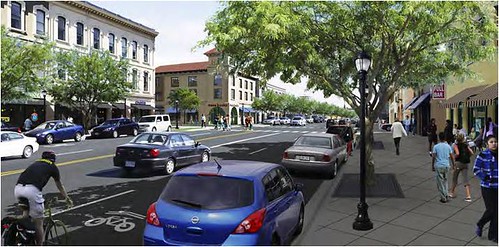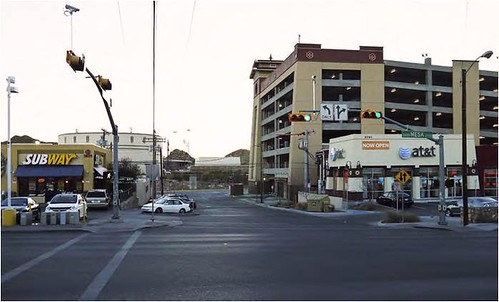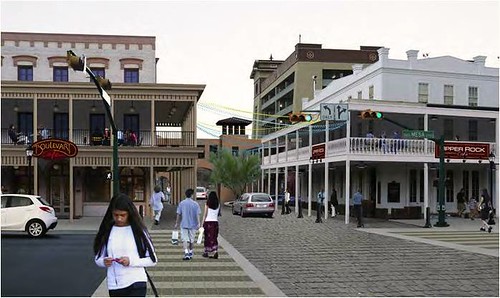It's unanimous: El Paso commits to a smarter, greener future

Posted March 8, 2012 at 1:27PM
Earlier this week, the city council of El Paso, the nation’s 19th-largest city, unanimously adopted a detailed comprehensive plan built around the principles of smart growth and green development. With significant economic importance and a rich cultural history, but plagued with sprawling recent development patterns coupled with alarming rates of land consumption and carbon pollution, the city constructed Plan El Paso over the past two years. It is among the best, most articulate comprehensive plans I have ever seen.
In January of last year, I reviewed Connecting El Paso, a precursor to the new comprehensive plan that focused on four key transit station areas. I called the document “a comprehensive guide to smart growth design and implementation” and predicted that it would be a winner when the year’s planning awards were handed out. Sure enough, in December the US Environmental Protection Agency honored the draft of Plan El Paso with a national award for achievement in smart growth, judging the effort as the year’s best example of outstanding “programs, policies and regulations.”
The plan has actually gotten better, and certainly more detailed (it runs some 900 pages in all) since I reviewed its predecessor. Early on, the new document makes clear that it is time for a bold new vision and commitment:
“In recent years health problems such as obesity, heart disease, high blood pressure, and the maladies associated with social alienation have become a normal response to a built-environment that does not allow walking or facilitate human interaction. The young and the elderly of El Paso, especially, have been left behind by urban forms that necessitate driving long distances. The plan proposes strategies to bring more of the activities of daily living within walking distance and a framework of transportation alternatives including transit and bicycle systems. Encouraging walkability helps create healthy life styles. Building complete places that enable neighbors to know each other will help create and retain close-knit communities . . .
“The plan recognizes the indispensability of beauty, not as something separate and apart from life like pictures in a gallery, but beauty in homes, neighborhoods, civic buildings, streets, and public spaces. In this way Plan El Paso aims not to return to a vanished time, but rather to grow a choiceworthy contemporary City based on cherished and enduring values. The plan revives the idea that additions to the built-environment must be functional and long-lasting but also delightful and attractive. Plan El Paso recognizes that design matters.”
From those premises, the plan gives priority to reinvestment in downtown; transit-supportive infill development; revitalization of older neighborhoods; balanced transportation options; strategic suburban retrofits; sustainable economic development; respect for nature; and much more. It also gives special recognition to the challenges and opportunities presented by El Paso’s location as an international border city and home to a large military installation, Fort Bliss.
Current San Jacinto Plaza and future vision
The undertaking involved substantial public engagement. Plan El Paso “deputized the entire City as citizen planners” with a series of hands-on public planning workshops comprising over eight weeks of intense community exercises and discussions to generate the plan vision. This process was followed by over a year of regular meetings with a citizen advisory committee to refine the draft plan. A project website that also welcomed discussion received over 30,000 visitors, and the process received bilingual coverage in local and national media.
In a guest column in the El Paso Times, city manager Joyce A. Wilson summarized both the effort and the accomplishment:
“Through one of the most expansive planning processes in a generation, Plan El Paso gathered the ideas and aspirations of thousands of El Pasoans. Over 20 citywide meetings were held in various neighborhood centers and libraries,
approximately 150 stakeholder meetings involved many of the region's most vital agencies, nonprofits, and businesses in the process, and a website (www.planelpaso.org) synthesized the plan's major ideas and policy recommendations . . .
“Plan El Paso offers ideas for the revitalization of our urban core. Other policy recommendations include increasing our tax base through traditional neighborhood design, preservation of our open space while planning for future infrastructure needs, increasing our transportation options in an era of increased oil demand and price, improving recreational amenities, developing walkable schools, and continuing our successful relationship with Fort Bliss.”
My experience has been that an informed public generally makes very good decisions about their community’s future, and that’s what happened here with the city’s planning “deputies.” They understood the need to live and work closer together, protect historic neighborhoods, and stop sprawling. Plan El Paso repeatedly acknowledges that its best ideas were locally generated.
Rapid transit corridors, with concentrated development in dark red
There is special attention paid to walkable development around the city’s transit stations (or stations-to-be), but the plan’s immense detail is testament to the recognition that every neighborhood is different, requiring a different approach to restoration and, where appropriate, growth. Each street and corridor presents distinct challenges and requires tailored solutions. They are all there.
Plan El Paso will now be implemented through annual work programs and budgets, development approvals, capital improvement plans, and economic incentives. The document is not itself a legal instrument, but it clearly recommends the use of progressive tools such as the SmartCode and LEED for Neighborhood Development, as the city crafts zoning and other legally binding measures to give the plan effect. Carlos Gallinar, El Paso’s comprehensive plan manager, told KVIA-TV reporter Darren Hunt that “wheels are already in motion to set six-month, one-year and five-year guidelines for the plan.”
Here are some examples of how the plan takes advantage of LEED-ND:
“Non-military development [near Fort Bliss] will be eligible for annexation into the City of El Paso provided it meets the LEED for neighborhood Development smart location standards . . .
“The City shall use LEED-ND as the basis for developing street connectivity standards for all new subdivision and land use development and redevelopment . . .
“Promote LEED-ND (LEED for Neighborhood Development) in order to rate proposed developments. Provide incentives to developers for creating LEED certified communities.”
The plan also highlights green building practices and linked parks and green space, while giving special attention to the sensitive environmental attributes of arroyos, common in and around El Paso and other parts of the southwestern US. The plan includes a new central park for the city (top image) on the site of an old rail yard.
When reviewing the precursor Connecting El Paso, I expressed a quibble regarding the relative absence of affordable housing strategies. I’m happy to say that my previous concern has largely been cured by Chapter 6 (“Housing”) of the plan, which contains extensive affordability analysis along with strategies. Compared to much of the country, El Paso is generally affordable, but measures are necessary to ensure that housing remains affordable to the right people for the right reasons in the right places, with attention and care to planning.
Under Texas law, the plan’s ability to influence development patterns outside city borders is nothing if not complicated. That’s a common problem with policy adopted by cities, but in El Paso there is some authority for the city to affect external land use indirectly. Among the strategies highlighted by the plan for limiting sprawl beyond the formal jurisdictional limits are (1) the city’s right to approve land subdivision in an “extraterritorial zone” reaching (with some exceptions) five miles beyond the city limits; (2) annexation; and (3) control over the extension of municipal water and sewer lines. Under policies preferred in Plan El Paso, expansion of the development footprint would be allowed only if proposed development parcels are contiguous to the existing city limits, do not transgress active farmland unless farming is maintained, and are built according to smart growth principles.
The process of constructing Plan El Paso was led by the terrific planning firm Dover, Kohl and Partners, whose work I have praised before. Both they and the city deserve recognition and high praise for setting a new standard for outstanding city planning. West El Pasoan Keith Pannell summed it up to KVIA-TV’s Hunt: "Anything they do to make the city more agreeable for people to live has my vote,"
Here’s a short video about Plan El Paso:
Move your cursor over the images for credit information.
